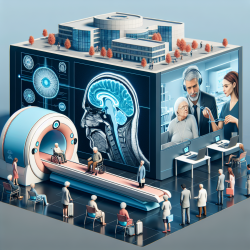This New MRI Technique Could Revolutionize How We Diagnose Neurodegenerative Diseases!

Are you ready to elevate your clinical practice to the next level? A groundbreaking study, "Technical note: can resting state functional MRI assist in routine clinical diagnosis?" by Harman et al., reveals how resting state functional MRI (RS-fMRI) could be a game-changer in differentiating between Alzheimer's disease (AD) and dementia with Lewy bodies (DLB).
Why Is Differentiating Between AD and DLB Crucial?
Differentiating between AD and DLB is essential due to the distinct treatment protocols required for each condition. Patients with DLB are hypersensitive to most antiemetic and neuroleptic drugs, which can lead to severe side effects like catatonia, loss of cognitive function, and muscle rigidity. Early and accurate diagnosis can prevent these adverse effects and improve patient outcomes.
The Power of RS-fMRI
RS-fMRI measures spontaneous brain activity by detecting changes in blood flow. Unlike task-based fMRI, RS-fMRI does not require patients to perform specific tasks, making it particularly useful for individuals with cognitive impairments.
Key Findings from the Study
The study by Harman et al. found that RS-fMRI can differentiate between AD and DLB based on functional connectivity patterns:
- Functional connectivity within the midcingulate network was lower in DLB patients compared to AD patients and healthy controls.
- Functional connectivity from the insula to the midcingulate was also lower in DLB patients.
These findings suggest that RS-fMRI could serve as an early biomarker for neurodegenerative diseases, assisting in accurate and timely diagnosis.
How Can You Implement RS-fMRI in Your Practice?
To integrate RS-fMRI into your clinical practice, consider the following steps:
- Upgrade Your Equipment: Ensure you have access to a 1.5 T MRI scanner capable of performing RS-fMRI.
- Training: Invest in training for your team to interpret RS-fMRI data accurately.
- Collaborate: Work with neurologists and radiologists to develop a standardized protocol for using RS-fMRI in diagnosing neurodegenerative diseases.
Encouraging Further Research
While the study shows promising results, more extensive research is needed to validate these findings. Clinicians are encouraged to participate in or initiate further studies to expand the data pool and refine the diagnostic criteria.
Conclusion
RS-fMRI offers a non-invasive, efficient, and reliable method for differentiating between AD and DLB. By incorporating this technique into routine clinical practice, you can significantly improve diagnostic accuracy and patient outcomes.To read the original research paper, please follow this link:
Technical note: can resting state functional MRI assist in routine clinical diagnosis?
Citation: Harman, P., Law, C., Pardhan, S., Lin, Z. H., Johnson, M., Walter, S., Fassbender, K., Aspinall, R., & Grunwald, I. Q. (2018). Technical note: can resting state functional MRI assist in routine clinical diagnosis?. BJR Case Reports, 4(4), 20180030. https://doi.org/10.1259/bjrcr.20180030










